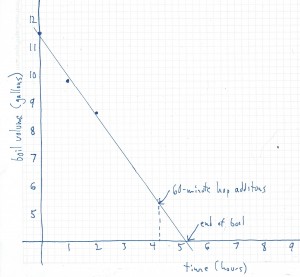This is the sixth article in this series on Russian imperial stouts.

A graphical method of estimating boil time. Plot wort volume vs. time as the boil progresses. Draw a straight line through your data points and extend it until it crosses the line that corresponds to your target wort volume. Work backwards to schedule your hop additions. (Click on picture to enlarge.)
Once you have produced your sweet wort, it’s time for the boil. Depending on the volume of wort you have collected, you may have a “regular-length” or extended boil ahead of you. There are a couple considerations that will apply when boiling any Russian imperial stout wort.
A Russian imperial stout is a big, hoppy beer. As such, there will be a lot of hop debris mixed in with the trub after the boil. You can lose a lot of high-gravity wort to this hop/trub mixture, so you will want to separate as much usable wort from it as possible.
If you have a hop jack, this is a great beer to use it with. Just move the aroma hops you would have added at knockout to the hop jack and use it to strain the hot wort on the way to your chiller. An in-kettle hop strainer or a funnel with a straining screen can also help filter the wort as it is being moved from the kettle to fermenter.
If you don’t have a hop jack, or other means of straining the wort, you could let the chilled wort settle after the boil for an extended amount of time — up to two hours. This will give the hop debris and trub some time to compact. After it has settled, you can draw the clear wort off the top. Additionally, you can save the remaining wort/trub/hop debris sludge in sanitized Mason jars in your fridge overnight. This will allow for additional settling time and allow you to recover a little extra usable wort.

Recent Comments